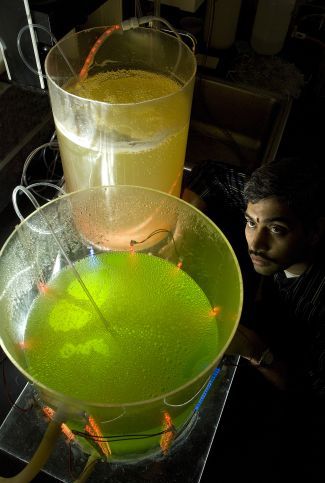
Publisher:
Bonnie King
CONTACT:
Newsroom@Salem-news.com
Advertising:
Adsales@Salem-news.com

~Truth~
~Justice~
~Peace~
TJP
Mar-04-2008 07:20

 TweetFollow @OregonNews
TweetFollow @OregonNews
Oregon Researchers Processing Bio-Fuels From Algae
Salem-News.comApplying the findings to mass-produce algae and extract its oils could be five to 10 years in the future.
 Researchers at Oregon State University are working to find an efficient method of processing bio-diesel fuel and ethanol from one of the world’s most plentiful organisms – algae – which could lead to breakthroughs in reducing the world's dependency on petroleum. Photo courtesy: Oregon State University |
(CORVALLIS, Ore. ) - Researchers at Oregon State University are working to find an efficient method of processing bio-diesel fuel and ethanol from one of the world’s most plentiful organisms – algae – which could lead to breakthroughs in reducing the world's dependency on petroleum.
Applying the findings to mass-produce algae and extract its oils could be five to 10 years in the future, but the advantages are worth the wait, according to Ganti Murthy, assistant professor of biological and ecological engineering at OSU.
Algae are versatile organisms that are "plant-like" but do not have a root system or leaves. Plants pull water and nutrients through their roots and release vapor through their leaves in a process called transpiration. The United States Environmental Protection Agency estimates that an acre of corn transpires about 4,000 gallons of water a day. Because algae do not have such a vascular system, they use water only as a medium for growing.
"In a closed growing system,” Murthy said, “algae require 99 percent less water than any other crop.”
Another advantage to growing algae is that varieties of the organism have been found flourishing in all kinds of environments – from the Arctic to tropical areas – and in both fresh and salt water. Therefore, Murthy said, growing algae "is not a food-versus-fuel issue; algae can be grown using waste-water and in areas that cannot support agriculture."
Algae also are highly productive compared to conventional crops. For example, a productivity model estimates that 48 gallons of bio-diesel can be produced from an acre of soybeans, whereas algae could produce 819 gallons – and theoretically as much as 5,000 gallons – from a single acre.
One of algae's most remarkable qualities is that it can grow using carbon dioxide generated from fossil-fuel combustion, according to Murthy. Greenhouse gases from industry and coal-fired electrical-generating plants can be piped to algae ponds, where carbon dioxide is a necessary ingredient for growth. In fact, research has shown that algae can grow 30 percent faster than normal when fed carbon dioxide emissions from fossil-fuel combustion.
At the OSU Sustainable Technologies Laboratory, Murthy has built two small photobioreactors to grow microscopic algae in a closed system. They are simple, plastic cylinders that have advantages over an open-pond system in greater productivity, reduced contamination and better control of growth. It takes about three weeks for the algae—combined with light, water, carbon dioxide and mineral nutrients—to multiply and turn the water green.
The primary focus of the OSU lab is to discover efficient ways to extract the oils (also called lipids) and process them into bio-diesel fuel and ethanol, with fertilizer and animal feed as co-products.
The biggest challenge, according to Murthy, is separating water from the micro algae he is testing (Chlorella and Dunaliella), which must continually be mixed with carbon dioxide and light as they grow. A combination of straining and centrifuging is the current method of extraction.
Of the more than 3,000 known strains of algae, Murthy grows both fresh water and salt water varieties. The photobioreactors hold about six gallons of water and produce about .17 pounds of algae with each batch.
"Depending on the algae growth conditions, we can usually extract 20 to 30 percent oil from it, and up to 60 percent is possible," he said.
Commercialization of algal bio-fuel and ethanol is a long way off. Yet, with many questions to answer and challenges to overcome, Murthy is undaunted. "A lot of people are working on it," he said, "It's just a matter of putting it together, making it work."
Murthy's work at OSU has been funded by a grant from the Agriculture Research Foundation.
Articles for March 3, 2008 | Articles for March 4, 2008 | Articles for March 5, 2008






Terms of Service | Privacy Policy
All comments and messages are approved by people and self promotional links or unacceptable comments are denied.
Fillmore Fuels March 4, 2008 8:58 pm (Pacific time)
Great article! There are many great uses for algae and fuel could be one of them. There is an online marketplace for algae and biodiesel http://www.FillmoreFuels.com
[Return to Top]©2025 Salem-News.com. All opinions expressed in this article are those of the author and do not necessarily reflect those of Salem-News.com.